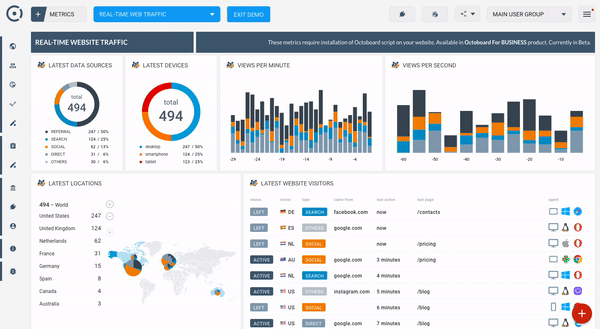In the era of free content, there’s hardly much info about how to use forward-looking metrics to improve sales on the net.
As Nimble is the CRM of choice for contact and task management, calendars, emails to hundreds of thousands of users, we decided to share our straight-from-the-field insights on the topic.
If you’ve always wanted to have a crystal ball at your disposal to be able to tell the future, stick with us to find out you have one already.
Sales metrics conundrum
Analysis paralysis is a disease many business owners suffer to a certain degree. Mostly spurred by the onset of big data, that can provide answers to many questions in the capable hands.
But not too many business analytics can turn the data into actionable insights or dig past the dirt and clutter of the raw data to see the forest behind the woods.
It’s the big eCommerce players, who mailed the art of big data analytics and can extrapolate the results derived from such analysis onto operational models with amazing ROI for companies.

On the other hand, B2B sales are hardly much about big data, but rather about mundane sales reporting with VIP accounts that need good digging and lots of insider market data to interpret.
On top of these sales metrics dilemmas, one is growing bigger and bigger. It’s not enough to know how you have been doing before and what your top-selling product is; overwhelmingly, businesses want to know the future trends, profits, churn rates to get ahead of the competition.
Sustainability of business and growth potential belongs to the dimension of the future. This is what businesses are now looking to get their hands on via reporting.
“Telling the future by looking at the past assumes that conditions remain constant. This is like driving a car by looking in the rear-view mirror.”
Herb Brody
This statement leads us to set out the types of sales KPIs as related to the period analyzed and the possibility to use the results of such interpretation beyond the present.
Types of sales KPI relative to time:
The majority of sales metrics used by businesses is to do with actual figures. There are 3 main types of KPIs relative to temporal dimension:
Historical metrics
These metrics are your actual numbers for past periods. They have to do with revenues, profits, costs, cash flow, margins, ROI, etc.
They allow business owners to review past achievements of the business across a myriad of endless KPIs.
On the other hand, such data also can be used to project the possible scenarios of the future upon, to build forecasts and budgets for next year. In these cases, the data is then adjusted based on market data, trends, internal factors.
Real-Time metrics
Real-time sales metrics are specifically pertinent for the eCommerce segment in terms of inventory management. Such KPIs usually report on vital processes, that is the every-day routine for a business, and which seamless flow ensures uninterrupted operational flow. Shipments, deliveries, page speed loading, order logs all belong to the real-time metrics.

This is when knowing your top-selling product will help an online store to stock up on the item in time without losing sales.
The dashboards with a live view usually contain critical data that needs to be addressed ASAP if gone wrong.
Forward-looking metrics [FLM]
What are the forward-looking metrics?
Forward-looking metrics are the business indicators that inherently contain the signals about the future performance of the business.
Examples of forward-looking metrics:
Intrinsically forward-looking metrics:
Some metrics are intrinsically forward-looking, like CLV, or pipeline.
- The pipeline, for example, is inherently about the future. It’s the top of the funnel, that extends into the future. The more leads a company has in its pipeline, the more revenue it will have down the line.
- CLV [customer lifetime value] is also an intrinsically FLM, as it has to do with the projection of the future earnings arising from each customer.
- Time-to-plateau and Gap-to-plateau are critical metrics about future company health that allow SaaS companies to address any potential issues with churn rate and marketing efficiency before it’s too late. They can be used by investors to predict the growth of the company based on the current churn rate and customer acquisition.
Hybrid FLM:
Many of the regular metrics can be rendered forward-looking when multiplied by the:
- Market & competitive data [insights about new competitors, M&As, new brand, etc]
- Industry trends [fading off – floppy discs, on the rise – electric cars, evolving – fast cloud technology, going through a tectonic shift, etc.]
- Global trends [pandemic, economic boom with increased purchasing power, etc]
- Internal company data [last stage R&D, new strong executive hire, relocation of HQ, financial difficulties, etc.]
In this case, even metrics about actual past performance may be used for predictive analysis about the future.
Why use forward-looking sales metrics?
PWC has come up with an extensive report on the use of forward-looking information in the corporate world, that we highly recommend checking out for publicly-trading companies. Meanwhile, we are providing some insight into SMB below.
To keep business afloat
If only the Titanic crew knew about the iceberg ahead.

On the same analogy, if you can decipher the sign of an upcoming disaster, you can prevent it all together at a small cost and stay alive.
To be ahead of competition & a trend-setter
There are different levels of leadership in the industry, being the trend-setter in the ultimate acme of industrial perfection.
Those who can predict the future will be able to become leaders of the future.
To be in a position to use cheap prevention, not expensive sure
You can patch up a small scratch with a bit of disinfectant and a cheap band-aid.
If it goes bad and inflamed, you can spend weeks in therapy using heavy antibiotics dosage to recover.
Similarly, if you know there is a crisis approaching, you can do with little investment to reverse it or spend millions to fight its devastating impact later.
How to improve sales with forward-looking metrics
Keep an eye on the competition
Are you keeping an eye on your competitors?
Do you follow their social media? Are you in the know of the upcoming projects? Does your HR monitor their vacancies? Do you have a Google brand mention set up for them? Does your industry comparative reporting give you the averaged figures for the market vs your company performance? Do you know of a major account moving business to them? Have you read about the new startup signing with your main competitor?
Your product may be at the top of the range, but if the entire range is top, your fight is endless.
You are only bad, good, or the best compared to your competitors.
Have your periscope zoomed in on the competition and you will be in a position to counteract their upcoming successes with your alternative interpretation.
Watch your pipeline
How often do business owners attend a sales meeting?

How do you celebrate the acquisition of a big account? Do you visit industry conferences to run shoulders with your coveted accounts and get a step closer to them? Do you have 2X-4X incentives for salespeople who get 100+ employee companies or, maybe, even a Fortune 100 ones?
Monitoring your pipeline will help get the feel of the coming year and take corrective measures early if needed. You can always apply the current growth and conversion trends to it and adjust for market conditions.
Observe your suppliers
You are a client to companies who supply the other players in the industry right?
Do they raise prices? Based on what? Do they expand in new markets? Have they run out of some items? Are they delaying deliveries?
Keeping a close eye on the suppliers will also help prevent multiple potential hiccups along the way.
A story about Automotive Group tells how a forward-looking projection of a 6% increase in steel prices leads to timely negotiations with the president of US steel, which leads to million-dollar savings from the company eventually.
Monitor your consumer trends
Keeping a finger on the pulse of your company trends across every major KPI with the forward-thinking cap is the privilege of a market leader.
New accounts per sales rep / Revenue per sales rep / Average check per sales rep – all of these metrics are hybrid metrics in their essence, as while they do contain the current data, they also signal about the future issues here and now.
Such a basic metric as turnover, that takes an upward or downward swing may tell a lot about the future market conditions, staff cost, automation investment.
The number of returns for eCommerce may also take a crystal-ball quality if scrutinized enough. Which items are being returned and why? Is it because of a lenient return policy that keeps your bottom-line anorexic skinny? Is it a new supplier you need to make an ex- ASAP? Is it down all of a sudden for a specific item, that needs an increase in price with all that demand?
Renewal Rate is another vital metric for the future of the SaaS company that needs close monitoring and digging.
Customer Acquisition Cost too needs to be extrapolated into the future and maybe prohibitive of the business survival at current rates. Do you need to drill down into your User persona? Do you need to reconsider your sales channel mix?
Win Rate is a major sales KPI and indeed, it is very much forward-looking. Alongside the number of deals and the average length of the sales cycle, it can alert you to the restructuring of the sales needed.
Nimble CRM: keeping the finger on the pulse of your sales
Analyzing the past is a must to better understand your business, trends, seasonality, customer, strength, and weaknesses.
Forward-looking sales metrics, meanwhile, can help move forward faster, with the road lightly lit, as opposed to the alternative of orientation in the pitch-dark room.
Learning to monitor FLM is easy and needs a bit of discipline.
Nimble CRM, one of the best CRMs according to Capterra & G2 Crowd, helps 140 000+ professionals structure their day and streamline all the processes.
- Use extensive Nimble reporting to get a comprehensive visual interpretation of the key sales metrics and extrapolate them into the future.
- Schedule FLM strategic sessions for sales reps in one click.
- Keep your forward-looking docs updated on a shared drive or attached to tasks, deals, and pipelines.
You can see why G2 Crowd awarded Nimble the top sales intelligence tool for SMB by trying this popular customer relations management tool for free for 14 days.
Make sure you take advantage of the Nimble Prospector extension during the trial period, as it will ensure your forward-looking pipeline is exploding with business!

